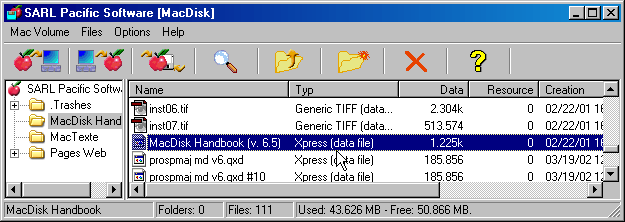 MacDisk for Windows
MacDisk for Windows
Presentation
MacDisk is an utility for reading, writing and formatting Apple Macintosh
magnetic media on an IBM compatible PC, without any hardware modification of
the computer and without any add-on.
MacDisk is a 32-bit application and runs under all recent versions of Windows
(Vista and 7/8/10 included, even 64 bits).
Supported Media
- HD (High Density) floppy disks (1.44 MB),
- Plain hard disks without any capacity limit (see also our page on Disk Interfaces and on Huge disks). Caution, Thunderbolt disks are not supported yet.
- CD-ROMs, pure HFS, hybrid (HFS/ISO 9660) and even ISO 9660 CD-ROMs with Apple extensions
- DVD-ROMs, which are in fact just huge CD-ROMs
- Iomega Zip cartridges, 100 and 250 MB
- Iomega Jaz removable disks, 1 and 2 GB
- External hard disks connected on the USB or FireWire (IEEE 1394) bus
- SyQuest cartridges, all capacities
- Bernoulli disks, all capacities
- USB media (keys, drives, token)
- Magneto-optical cartridges of 128 and 230 MB (3.5") and of 300, 350, 600, 650 MB (5.25").
Macintosh CD-ROMs are managed as read-only volumes. If you want to create
Macintosh CD-ROMs or DVD-ROMs on your PC, please check
MacImage.
All kinds of Zip cartridges are supported
(be it on SCSI bus, on USB bus, on IDE/ATAPI bus or on the parallel port).
Under Windows 2000 and higher, we don't use the Aspi layer any more, but a service
launched under the local system. See the MacDisk data
sheet and the Lsdiorw page.
File System Compatibility
MacDisk manage the old HFS volumes (classical magnetic Macintosh media)and the recent HFS+
format (also called Extended Mac OS, journalled or not).
MacDisk, when launched from a Windows partition created by the boot manager
Bootcamp on a Macintosh with Intel processor, can access the Macintosh partition
to copy files back and forth.
Why MacDisk?
MacDisk is aimed at all users needing to exchange data files between the
Macintosh and the PC.
MacDisk is an indispensable tool for data exchanges between sibling applications
that exist in both Macintosh and PC (Windows) versions, like MS-Word, MS-Excel,
PageMaker, Quark Xpress as well as transfering compatible data formats (Ascii,
graphical files).
To get a better understanding of MacDisk features, you can download the
Help File.
MacDisk Version 8.0
MacDisk is a 32-bit program. The latest version for Windows 2000 and higher adds
many new functions: it now supports all CD-ROM drives (SCSI, USB, IDE/ATAPI),
all kinds of CD-ROMs (HFS, HFS+, hybrid, even multi-session ones). The 32-bit
version is much faster than former ones. For an example, a 80-MB file is copied
from the CD-ROM drive to the hard disk in less than a minute!
More, the new interface offers an Explorer bar to navigate the Macintosh volume
and a listview which allows to sort the items according to the name, to the type,
to the data or resource length, to the creation/modification date and to the
signature.

This feature is very interesting, for an example if you get an USB token with
both Word and Excel files. A sort according to the signature will allow you to
copy selectively the Word files in a specific subfolder and the Excel files in
another one. Likewise, if you do DTP, you'll be able to copy selectively the
Tiff pictures, the EPS files and the layouts.
See our Preview Page on its new
features and its new user interface (with numerous screen captures).
And What About DD Floppy Disks?
MacDisk cannot read Apple Macintosh DD (400 KB or 800 KB) floppy disks.
Apple chose to implement the GCR coding (Group Coded Recording) with
a variable spindle speed to squeeze more data on the outer tracks of the medium.
There are no software solutions to mimic that on the PC, and the existing
hardware solutions become more and more of "historical nature" (Central Point
Option Board DeLuxe, Apple external floppy drive connected to a MicroSolution
controller).
However, I recently learned that one of those cards is still available: the
Catweasel board can read DD images
with a normal PC-floppy (connected to it) as well as many other formats.
For the time being, the only practical solutions is to find a working Macintosh
with a floppy drive to copy the files onto another floppy (HD) or another
medium.
MacDisk Features
MacDisk manages the Macintosh signatures and adds
a corresponding extension to the files copied from the Mac to the PC.
Conversely, MacDisk gives a signature to the files copied on the Macintosh
volume to make "double-clickable" icons. The lookup table is freely editable
(with the SignEdit utility).
MacDisk is a low-level disk utility and not a conversion program. It doesn't
modify the contents of the files (to avoid yet another source of problems). It
is bundled with MacText, a little text converter
aimed at some Macintosh text formats.
Cross-Platform Compatibility
Most big applications existing on both platforms open the files created on the other platform. That is, Word for Windows opens Word Mac files. This holds true also for Excel, PageMaker, Xpress and many others. See our Hints & Tips for more information about converting and transferring data files between Macintosh and PC.
Font Transfers
From version 4.5, MacDisk offers certain features to transfer and convert
font files between the Macintosh and the PC.
How to Buy MacDisk?
To Go Further...
- MacDisk data sheet
- Hints and tips on exchanging formats between applications
- Download a demo package to check yourself what the program may do for you
- Testimonials Page (a few sentences may say it better than thousand words...
3, rue Pierre Haret - F-75009 Paris (France) - Tel. (+33) [0]149 700 455
web: http://www.macdisk.com